
Catalog excerpts

Sika Facade Systems Sealing and Bonding in Facades - Specification Guide
Open the catalog to page 1
Glazing Technologies Supplementary curtain wall solutions Ancillary Products Peek & Cloppenburg Store, Cologne, Germany
Open the catalog to page 3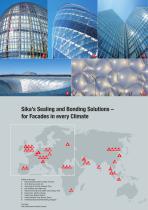
Sika’s Sealing and Bonding Solutions – for Facades in every Climate Projects on this page: 1 Peek & Cloppenburg Store, Cologne, Germany 2 30 St. Mary Axe, London, UK 3 Zhang Jiang Hi-Tec Park, Shanghai, China 4 New Exhibition Center Milan, Italy 5 National Swimming Center (Water Cube), Beijing, China 6 Equity Tower, Jakarta, Indonesia 7 Crystal Tower, Manama, Bahrain 8 Russia Federation Tower, Moscow, Russia 9 One Marina Boulevard (NTUC Building), Singapore Front page: ADAC Head Quarters, Munich Germany
Open the catalog to page 4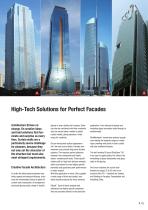
High-Tech Solutions for Perfect Facades Architecture thrives on change. On creative ideas and bold solutions that fascinate and surprise us every time. Curtain walls are a particularly severe challenge for planners, because they not only set the character of the structure but must also meet stringent requirements. Creative Facade Architecture To strike the ideal balance between aesthetic appeal and energy efficiency, architects are increasingly turning to glass for curtain wall construction. As transparent structural glazing walls, single or double glazed or even double skin facades. Glass...
Open the catalog to page 5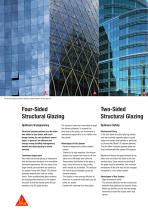
For structural glazing silicone adhesive sealants Sikasil® SG see page 16. Four-Sided Structural Glazing Two-Sided Structural Glazing Optimum Transparency Optimum Safety Structural glazing systems can be either two-sided or four-sided, with each design having its own particular advantages. In general, for efficient and energy-saving building management, double and triple glazing is recommended. Frameless Appearance Four-sided structural glazing is impressive first and foremost because of its monolithic frameless appearance. All four sides of the large-format pane element are bonded to an...
Open the catalog to page 6
13 For UV-resistant weather sealing between the glass panes with Sikasil® WS silicones see page 27. 14 For the appropriate fin glazing silicone sealants Sikasil® SG and Sikasil® WS see page 30. 15 For details of window bonding see www.sika.com/windows Bolt-Fixed Glazing Total Vision Glazing Structural Window Bonding Frameless Appearance Slim and Energy Efficient Design Mechanical Fixing In bolt-fixed glazing systems, the glass elements are fixed to cable systems or metal beams by metal fasteners. These fasteners are embedded in holes in the glass pane with “glass cement”. The glasses can be...
Open the catalog to page 7
16 Stock Exchange; Johannesburg, South Africa 17 Zorlu Plaza, Istanbul, Turkey Structural Glazing – Sophisticated Architecture and Innovative Technology Structural glazing modules are subject to extremely high stresses. They must accommodate wind and snow loads as well as thermal expansion, and permanently transfer the forces to the support structure, while also withstanding weathering over many years. Specialized Products Durable Construction High-modulus Sikasil® SG silicone adhesive sealants offer the best properties for this purpose. The latest development with highest design factor is...
Open the catalog to page 8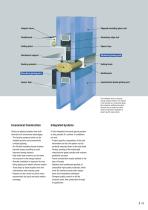
Adapter frame Stepped insulating glass unit Secondary edge seal Setting block Spacer tape Mechanical support Structural glazing joint Backing material Setting block Structural glazing joint Spacer tape Symmetrical double glazing unit The illustration shows a structural glazing module prototype. This diagram is not intended as a construction guide. More elaborate, additional structural elements may be needed to satisfy national construction regulations or project-specic requirements. Economical Construction Integrated Systems Structural glazing facades have both technical and economical...
Open the catalog to page 9
18 Airport Barajas Madrid, Spain; Richard Rogers & Estudio Lamela Joint Design – Correct Planning is Essential In structural glazing, the adhesive joints should be planned and arranged according to optical requirements, but they should also take into account dimensional changes in the adjacent parts under the effect of temperature and the movement capability of the silicone adhesive. The joint design thus combines shape with functionality. Important Seven criteria must be observed: 1. The joint seal must be able to freely accommodate tensile and compressive movements between the joint...
Open the catalog to page 10
h e h joint bite e joint thickness 18 Airport Barajas Madrid, Spain; Richard Rogers & Estudio Lamela Calculating the Joint Bite h Typical Stress/Strain Diagram ofwind Joint bite h as a function of the Sikasil®supported constructions: load in SG-500 Joint bite h as a function of the dead load in non-supported constructions: Joint bite h as an interaction of combined tension and shear load: Mohr tension cycle minimum bite of the adhesive joint (mm) minimum bite of the adhesive joint (mm) length of the short edge of the glass pane or of the element (mm); with irregularly dimen- sioned glass...
Open the catalog to page 11
A Right joint dimension in its original state (h = joint bite, e = joint thickness) B Besides tensile movements the adhesive bond C also absorbs shear movements in all directions. D It is essential that bonding on three sides is avoided. Glass pane Structural glazing joint Calculating the Joint Thickness e With all structural glazing constructions, the adhesive bond is subject to considerable shear movements. The joint thickness (glue line thickness) must therefore be designed so that the movement capability is not exceeded. Criteria for Calculating the Joint Thickness e - Dimensions of the...
Open the catalog to page 12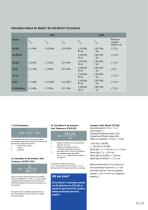
Calculation Values for Sikasil® SG and Sikasil® IG products ETAG Movement capability (ASTM C719) 3b. Calculation of the minimum Joint Thickness e (ETAG 002) The calculated deformations of the long and short panel edges yield the total movements according to the formula above (Pythagoras’ theorem). ∆l = total change in length v = vertical h = horizontal 3a. Calculation of the minimum Joint Thickness e (ASTM C1401) Sikasil® SG silicone adhesive sealants are permitted maximum elongation of ±12.5% (c = 0.125). The total of expansion and contraction must not exceed 25%. With these restrictions,...
Open the catalog to page 13All SIKA INDUSTRY catalogs and technical brochures
-
Sikasil® SG-20
2 Pages
-
sikia
2 Pages
-
glass
5 Pages
-
Sikasil® WS-605 S
4 Pages
-
BONDING EXCELLENCE
4 Pages
-
AUTO GLASS REPLACEMENT
28 Pages
-
ASSEMBLY LINE ADHESIVES
9 Pages
-
ACOUSTIC SYSTEMS
9 Pages
-
SikaFast®-5221
2 Pages
-
Sika®Aktivator
2 Pages
-
SikaLastomer®-710
2 Pages
-
Sikaflex®-221
2 Pages
-
Fenestration Systems
12 Pages
-
SikaForce®-7718 L100
2 Pages
-
Sikaflex®-290i DC
2 Pages
-
Sikasil® WS-355
2 Pages
-
Sika® Primer-290 DC
2 Pages
-
Solar Solutions
12 Pages
-
Automotive - Realising Visions
20 Pages
-
Sikaflex® - General Guidelines
12 Pages
-
Industry Product Catalogue
20 Pages
-
Sikkagard 700S
3 Pages
-
SikaTack® Drive
2 Pages
Archived catalogs
-
SikaMelt®-601
2 Pages
-
Sikaflex®-521 UV
2 Pages
-
Sika hotmelt
5 Pages
-
Product Catalogue
20 Pages







































